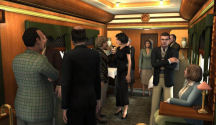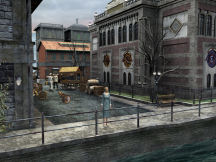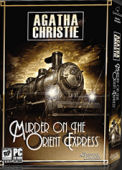The Orient Express -- an opulent train speeding through
Eastern Europe, an emblem of glamour and romance.
But for Agatha Christie fans, the Orient Express means murder – a
perplexing crime which takes place between the two world wars. The only
detective who can solve the murder? Hercule Poirot, a last-minute
passenger on that fated journey.
The PC version of Murder on the Orient Express takes the
characters from the Agatha Christie novel, adds new characters and
settings, then reshapes them into a captivating adventure with an
alternate explanation of the mystery.
Meet Antoinette
After a cinematic flashback, the game begins outside the Sirkeci
Terminal in Istanbul, Turkey – the year is 1934. It’s clear that care has
been taken to keep the environments and characters true to their
historical context. You assume the role of the intelligent and beautiful
Antoinette Marceau, an employee of the Orient Express. Antoinette has
been instructed to see that Hercule Poirot’s journey goes smoothly (an
impossible task, given what is about to occur).
Once on the train, the two trade friendly observations about their
fellow passengers. Antoinette has been collecting newspaper clippings
from recent celebrity murders. She hopes to learn much from the famous
detective. Little does she know that an avalanche will soon stop the
train and a bizarre murder will take place in the compartment next to
Poirot’s.
Antoinette functions as the chief investigator of the crime, since the
local police can’t reach the train and Poirot is injured and keeps to his
bed. Having Antoinette perform the investigative “footwork” adds drama to
the plot, as she is more vulnerable to danger and more apt to jump to
conclusions. This is not to say that Poirot is missing in action. Not
only is it necessary to converse with him while analyzing the various
clues, but you will hear his voice continually through the game. He lets
you know when certain things are noteworthy, and provides almost
telepathic praise and criticism.
Getting Somewhere
Orient Express is a mouse-controlled point-and-click adventure,
viewed from a third person perspective. Convenient directional cursors
guide your steps. Left clicking causes Antoinette to walk; double
clicking either causes her to walk quickly or results in a screen dissolve
that brings you to the next location. (Antoinette looks distinctly odd
when walking quickly, so it’s fortunate that this happens only rarely in
the game.) For most of the game you can skip between sections of the
train by moving the cursor to the top of the screen and clicking on each
individual car.
Is this Heaven? No, it’s a Train Station
The environments in Orient Express are detailed and sumptuous.
The most awe-inspiring is the Sirkeci Station, especially its interior
where sunlight streams through the rose window and marks a halo on the
floor. Outside the station, small movements bring the world alive – a
spray of leaves moving in the breeze, smoke rising from a chimney.
When the train comes to rest in a frozen landscape, you’ll see some of
the interiors through the frosty glass of the windows with snow falling
all around. The Orient Express lives up to its luxurious reputation.
You’ll find decorative flourishes like etched glass, inlaid wood,
elaborate carpets and cut flowers in every room. This portion of the game
features an unusual variety of camera angles and different sources of soft
light to add visual excitement to the enclosed spaces. My only quibble
with the locations -- there just weren’t enough of them. I wanted to see
more at other train stops along the way.
Not the Usual Suspects
A rich cast of characters clusters around Poirot and Antoinette.
You’ll meet a Russian Princess, a Hungarian diplomat, a German chef who
undervalues vegetables and an American tourist who never stops
complaining. A lot of time is spent interacting with the characters.
Some of the dialog is straight from the novel and the rest fits seamlessly
with the atmosphere and the characterizations. You can click through
dialogs to speed things up whenever you like.
Voice-overs on the whole are impressive. David Suchet draws upon his
multifaceted talent and insight into the role he developed while
portraying Hercule Poirot in the Agatha Christie’s Poirot
television series. Kudos also for Vanessa Marshall’s performance in the
role of Antoinette Marceau. I could listen to her voice all day.
The game contains some quips that are good for a laugh, as well as some
poignant lines that speak to later historical events – the British
governess who’s given up a job in Baghdad, for instance, because nothing
ever happens there. Character models are a bit stiff, but they are
significantly improved since the previous Agatha Christie game (And
Then There Were None). Lip synch is hit-and-miss. Character
animations vary, with some suspects gesturing as they speak, while others
remain more stationary.
The final cutscene wherein Poirot reveals all the layers of the mystery
is unusually clever. Poirot sets the scene with his deductions and then
asks you to identify the supporting evidence. The game’s ending is quite
a surprise; it is affecting and effective.
Footprints in the Snow…
The puzzles in Orient Express involve exploration, interrogating
(and shadowing) suspects, and working with the inventory. One area is
maze-like, especially when you traverse it in blizzard conditions – an
inventive variation on the traditional maze.
A vital part of the game is the Inventory Menu, which contains several
features that you must figure out in order to progress (I strongly
recommend reading the manual for this). All inventory items can be viewed
closely for additional information. A few items can be taken apart and
others can be combined. With a couple of exceptions, inventory
combinations are realistic and sensible. There is also a place for
comparing fingerprints, for viewing passports, and a scrapbook containing
various documents – including an essential list of Poirot’s instructions.
Methodical exploration of the surroundings (don’t forget to listen at
doors and rummage through the suspects’ belongings) and the interrogation
of witnesses nudges the game along nicely. Sometimes there is a gap in
time between discovering a clue and being able to grill the appropriate
suspect about it – but eventually you’ll trap many of the suspects into
admitting their previous lies and misleading statements.
Eat Your Heart Out, James Bond
Music in Orient Express is limited to the cut scenes, though
ambient sounds are so good that I didn’t notice this until the second
play-through. The music ranges from the ominous to the exhilarating.
Running strings evoke the motion of the train and the combination of
zither and gong hint at a journey into the enigmatic East. There’s also
an amusing “Hercule Poirot” theme. For the rest, ambient sounds work well
to immerse the gamer in the environment. You’ll hear voices in the market
place, the hiss of escaping steam, crunching snow, and the howling wind.
The Downsides
I have a couple of complaints about Orient Express. Most of the
story takes place in the four main cars of the train. The gameplay
involves going over the same locations and interrogating the suspects
again and again, so by the end it started to feel repetitive. I probably
searched the suspects’ suitcases six or seven times because items could be
hidden in previously searched places. I also grew tired of the lengthy
finger and footprint matching activities, although these did provide a
strong dose of realism.
There was a minor inconsistency in the game. In two places you can’t
use the usual inventory combination screen. This created some
gnashing-of-teeth moments as I tried to combine items using the inventory
combination screen when I should have (for instance) used the surface of a
nightstand.
To Challenge or to Cooperate?
Early in the game, you are given the choice to challenge Hercule Poirot
to see if you can solve the crime as efficiently as he would, or to
cooperate in solving the crime using him as a partner. I played the game
first in Challenge and then in Cooperative Mode. I strongly recommend
using the Challenge Mode.
I found that cooperating with Poirot gave me information that I could
easily figure out on my own, but never gave me information that would have
helped when I was stuck. In Cooperative Mode, Poirot gives hints about
where to use an inventory item, or suggestions as to where something might
be found, or general exhortations to keep going.
But in a game this complex, for Cooperative Mode to really be helpful
the game would need to keep track of whatever you have missed that is
keeping you from progressing. And that it doesn’t do. Instead, as you
desperately try to figure out the one item/clue/inventory combination you
haven’t stumbled across, Poirot “cooperates” by giving you a general
instruction to keep searching and interrogating suspects – the same things
you’ve been doing all along.
In Challenge Mode, you sense more of the detective’s smugness as he
informs you that he would have done something differently (and docks you
points for your clumsiness). That’s an improvement on begging for help
he won’t give you, however.
Quick List for Agatha Christie: Murder on the Orient Express
An eye-catching mystery adventure based on the Agatha Christie novel.
Introducing Antoinette Marceau, a likeable new assistant to Hercule Poirot.
An international cast of suspects, excellent voice-overs. Poirot is
voiced by the inestimable David Suchet. Plenty of character interaction.
You can click through dialogs.
Exquisite, detailed environments, though their number is limited. More
exploring and a bit less talking would have provided better gameplay
balance. There’s a clever, satisfying ending that differs from the novel.
Third person perspective, point-and-click interface. Two modes of
play, “Challenge” or “Cooperative” – puzzles stay the same, Cooperative
Mode gives more clues. You cannot die. One amusing inconsistency –
kidnappers don’t need snowshoes.
Various inventory challenges, interrogation of suspects, exploration
and searching. (Read the manual to understand how to work the
inventory.) A puzzle box, a combination safe and a jigsaw puzzle. One
memorable maze. No timed puzzles, no sound or music puzzles, no puzzles
that require color discrimination. You’ll pick up lots of items/clues –
if you accidentally skip one, it can be difficult to figure out what
you’ve missed. The most difficult puzzle: an inventory challenge requiring
multiple steps to decombine/combine items, while using unconventional
ingredients.
Occasionally, load times are long. No problems with installation; no
glitches during gameplay. Unlimited save slots and you can name the saved
games.
Agatha Christie: Murder on the Orient Express is aimed at
adventurers who enjoy a good historical mystery with compelling
characters, gamers who relish a logical crime investigation, and fans of
Agatha Christie.
Final grade: A-
My Computer Specs:
Windows XP Professional
Pentium 2.80 GHz
2046 MB RAM
Direct X 9.0c
512 MB NVIDIA GeForce 7800 GTX
SB X-Fi Audio
November 2006
design copyright ©
2006
GameBoomers
Group




